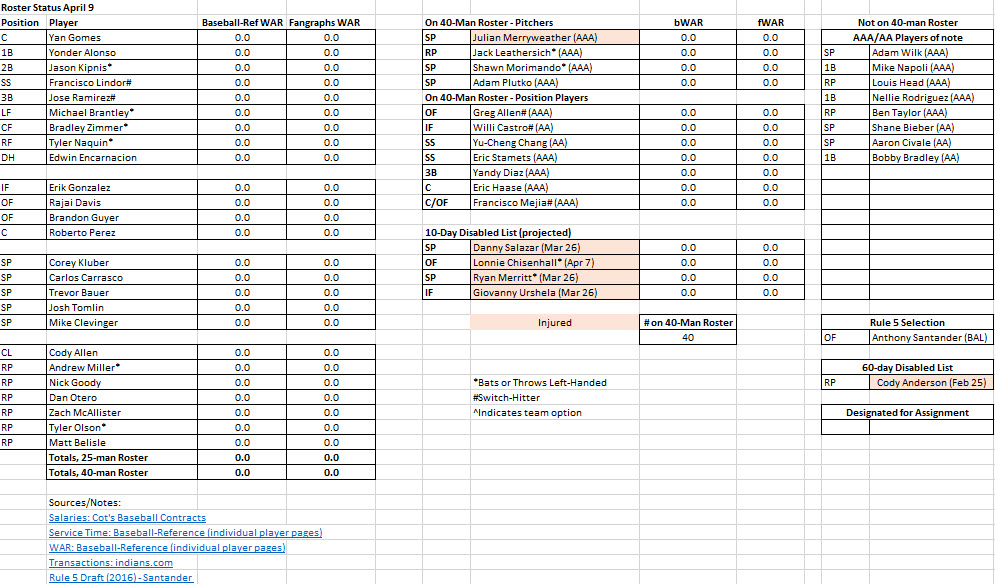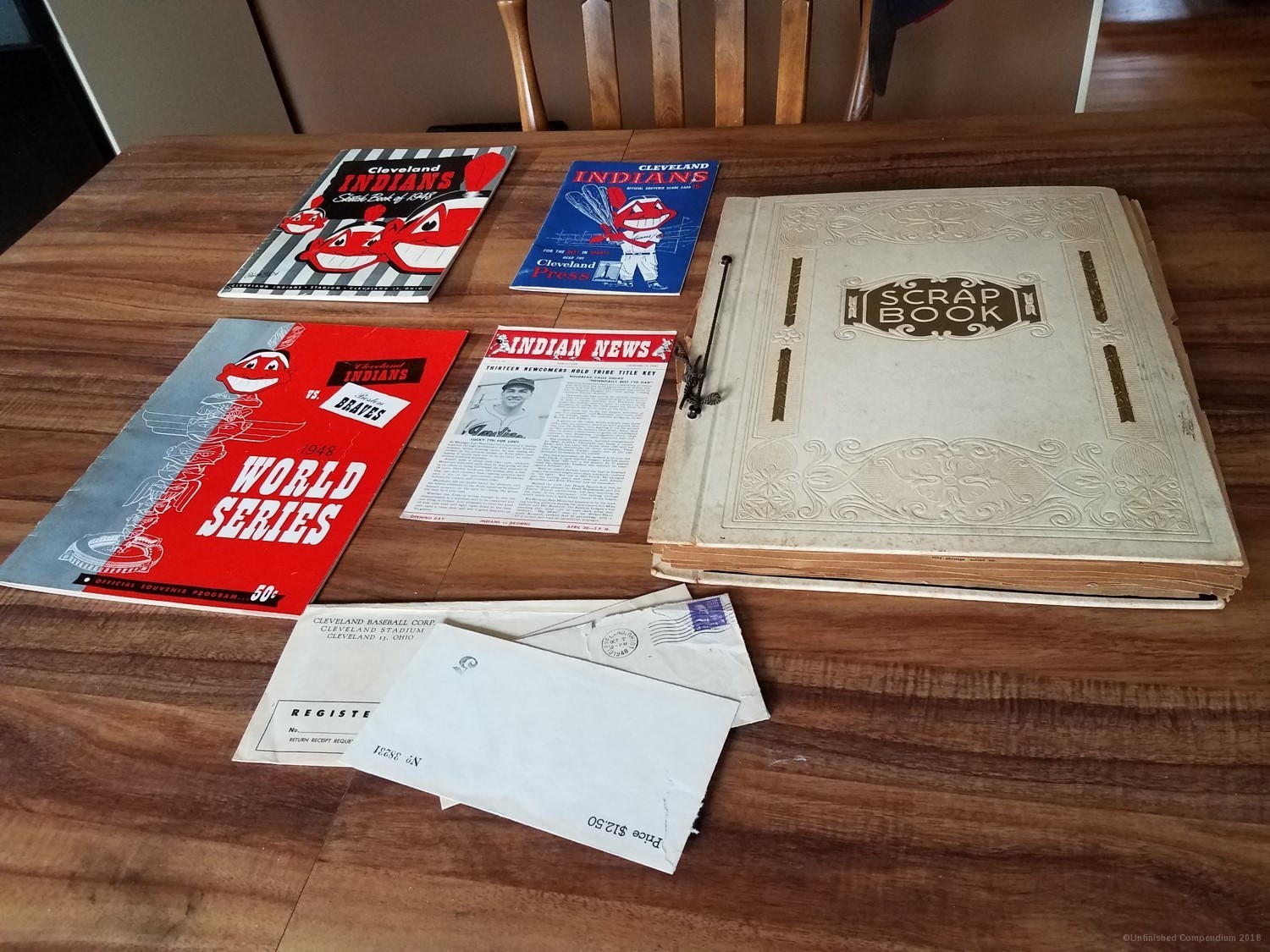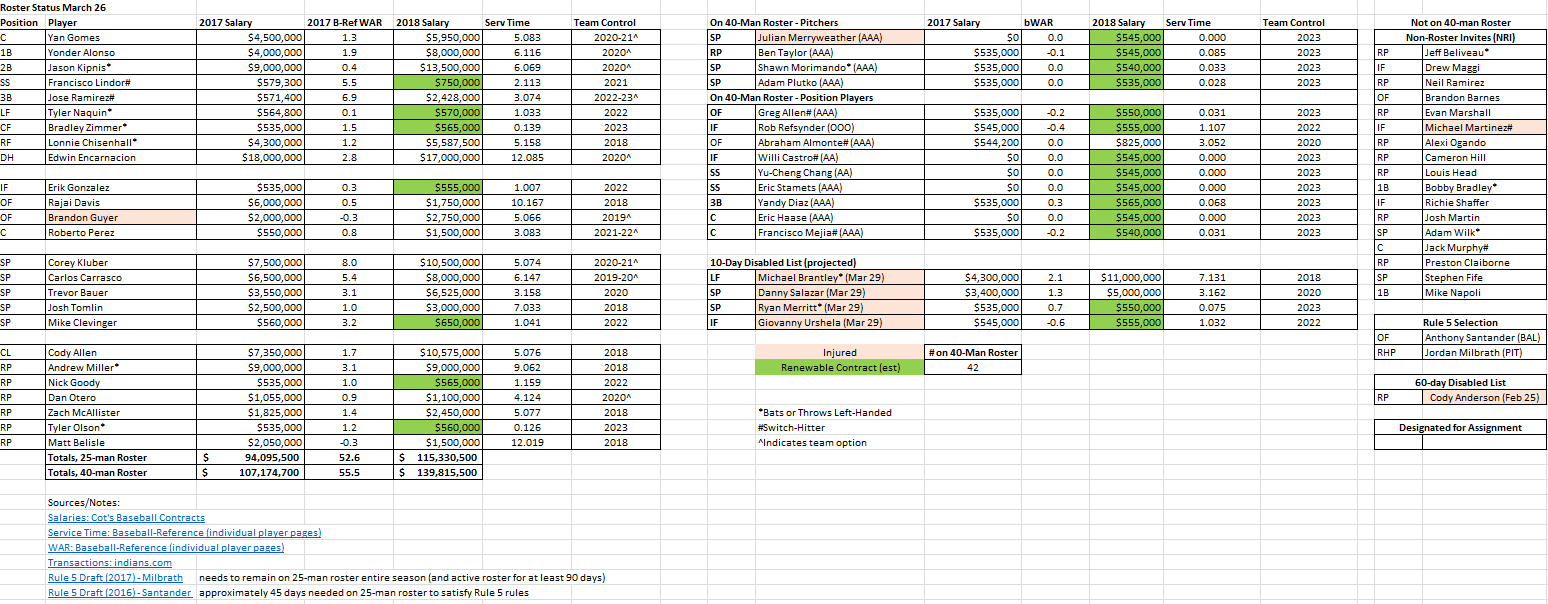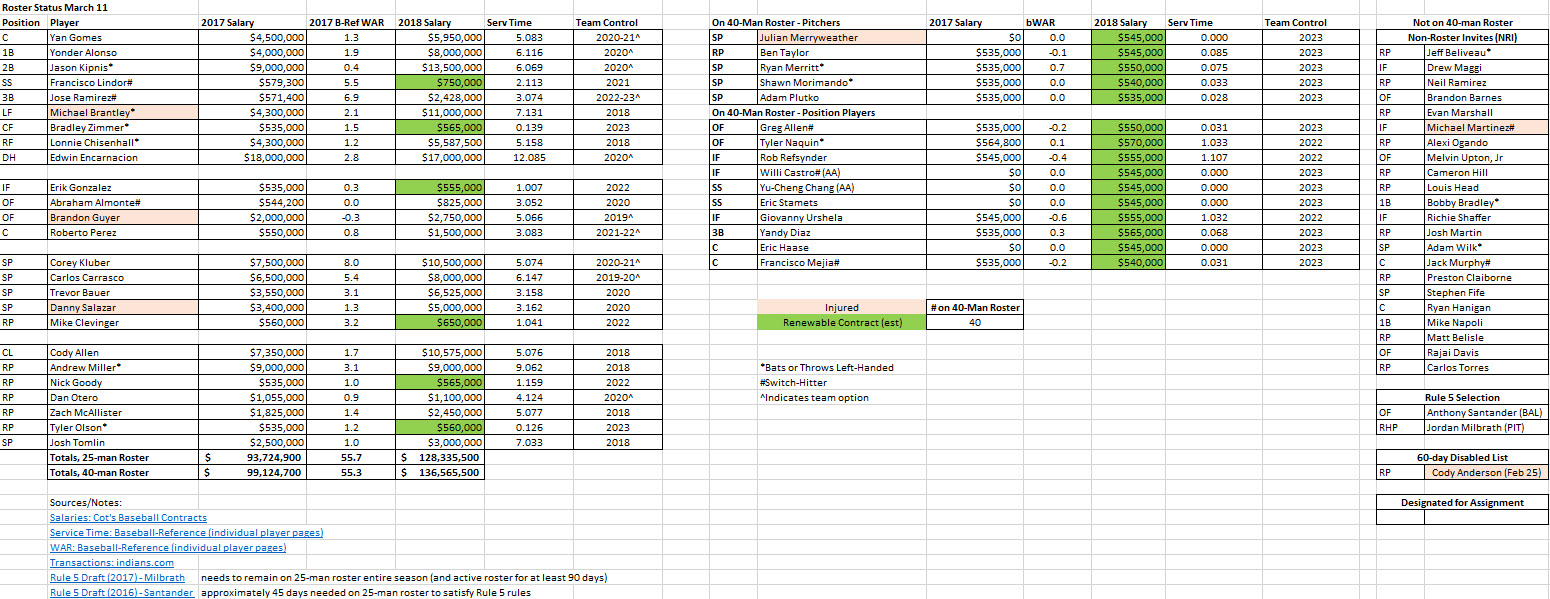I apologize for the lack of content over the past month. To make up for that lull, there should be several posts coming soon.
A roster post should be up in a couple days detailing all the moves the Indians had to make to deal with the bullpen implosion. I’ll also take a look at the decision to designate Giovanny Urshela for assignment rather than Erik Gonzalez; hopefully by then the DFA process will have played out, and I can take that into account.
Also I hope to finish the next part of the 1948 Treasure Trove series in the next week or so, which will cover the Sketch Book.
After a month of baseball, the Indians are in first place, but they are not running on all cylinders. Were the Indians in any other division, they’d be in at least second place, and in one instance (NL Central) last place.
The culprits are twofold. The team at first struggled to score runs, and of late have given up runs in the late innings. The latter happened, not coincidentally, after Andrew Miller went on the Disabled List. I don’t think Miller’s injury directly caused the rest of the bullpen to implode, but Miller’s presence allowed the Indians to get away with a lot of substandard relief pitching, and with that gone the rest of the bullpen was exposed. Zach McAllister, for example, had not exactly been a stalwart as Bryan Shaw’s replacement, but Terry Francona had Miller out in the bullpen as a security blanket. But without Miller, there was only Cody Allen to bring in if something went horribly wrong, and you can’t expect Allen to be able to throw multiple innings more than a couple times a month without it eventually affecting his performance.
A Game-by-Game look at the bullpen
Let’s go game by game since Miller’s injury, looking at both usages and performances by the bullpen. I’ll ignore instances of the Indians trailing when the starter left the game, though those instances didn’t exactly feature stellar relief performances either.
April 25th: Indians 4, Cubs 1
Starter: 6.2 innings (Trevor Bauer, 111 pitches) – lead 3-1
Andrew Miller: entered 6.2 (0.0 innings, 0 runs, left with injury)
Tyler Olson: entered 6.2 (1.0 inning, 0 runs)
Nick Goody: entered 7.2 (.1 inning, 0 runs)
Cody Allen: entered 8.0 (1 inning, 0 runs)
This is how games usually went the last couple of years; the starter gets the game to the 7th inning or later, the back end of the bullpen shuts the other down to finish the game. Goody and Olson were pitching in unaccustomed roles, but they rose to the occasion.
April 26th: Mariners 5, Indians 4
Starter: 6.0 innings (Mike Clevinger) – trail 4-0
Dan Otero: entered 6.0 (1.1 innings 0 runs)
Jeff Beliveau: entered 7.1 tied 4-4 (.1 innings, 0 runs)
Nick Goody: entered 7.2 tied 4-4 (.1 innings, 1 run)
Zach McAllister: entered 8.0 trailing 5-4 (1.0 inning, 0 runs)
Goody, who entered into a tie game, was the culprit this night. Had Miller been available, he probably would have finished off the 8th inning.
April 27th: Indians 6, Mariners 5
Starter: 8.2 innings (Corey Kluber) – lead 6-2
Cody Allen: entered 8.2 (.1 inning, 2 runs)
Allen allowed an inherited run to score along with two of his own.
April 30th: Indians 7, Rangers 5
Starter: 6.2 innings (Trevor Bauer) – tied 2-2
Tyler Olson: entered 6.2 (.2 inning, 2 runs)
Cody Allen: entered 7.1 trail 4-3 (1.1 innings, 1 run)
Jeff Believeau: entered 8.2 lead 7-4 (.1 inning, 0 run)
Allen entered in the 8th inning, a spot that Andrew Miller would certainly have filled. Allen would throw 41 pitches before being relieved in the 9th inning. You usually don’t see that kind of workload in a single game in the regular season.
May 2nd: Indians 12, Rangers 4
Starter: 7.0 innings (Corey Kluber) – leading 10-3
Dan Otero: entered 7.0 lead 10-3 (1.0 inning, 1 run)
Ben Taylor: entered 8.0 lead 12-4 (1.0 inning, 0 run)
No drama here. Otero and Taylor (making his Indians debut) did well in mopup duty.
May 3rd (Game 1): Blue Jays 13, Indians 11 (11 innings)
Starter: 5.1 innings (Carlos Carrasco) – tied 7-6
Nick Goody: entered 5.1 lead 7-6 (.2 inning, 2 runs)
Zach McAllister: entered 6.0 tied 7-7 (1.2 innings, 1 run)
Ben Taylor: entered 7.2 trail 9-7 (.1 inning, 0 run)
Cody Allen: entered 8.0 tied 9-9 (1 inning, 0 run)
Dan Otero: entered 9.0 tied 9-9 (1 inning, 0 run)
Tyler Olson: entered 10.0 tied 9-9 (1 inning, 4 runs)
This mess of a game was set in motion because of a short outing by Carlos Carrasco. In what has become a recurrent theme lately, the Tribe offense mounted a furious comeback, only to see it given away late by the bullpen. That this was the first game of a doubleheader affected some of the pitching moves by Terry Francona only somewhat; Francona is never shy about going for a game in front of him, leaving the next game until tomorrow (or in this case, an hour from now).
May 3rd (Game 2): Indians 13, Blue Jays 4
Starter: 7.1 innings (Adam Plutko) – lead 13-3
Evan Marshall: entered 7.1 lead 13-3 (.2 inning, 0 run)
Jeff Beliveau: entered 8.0 lead 13-3 (1.0 inning, 1 run)
Thank goodness for Adam Plutko, as his performance (along with the Tribe offense) allowed Francona to get through the game without having to use any reliever in both games. Not that that would help any in New York.
May 6th: Yankees 7, Indians 4
Starter: 7.1 innings (Mike Clevinger) – lead 4-0
Cody Allen: entered 7.1 lead 4-0 (.2 inning, 3 runs)
Dan Otero: entered 8.0 tied 4-4 (.1 inning, 2 runs)
The curious decision to go with Cody Allen in the eighth inning of a game that the Indians led by 4 runs seems to be a product of the previous week’s worth of games. Francona had seen just about every reliever on the staff implode at some point or another, and that includes several pitchers that had since been cycled back to the minors. With a off-day looming, he thought he could push Clevinger to 110 pitches or so, then rely on Allen to get the final 3 (or possibly 4) outs. As it turned out, the tiring Clevinger couldn’t stay in the strike zone, and so Allen had to be brought it to get 5 outs. Cody couldn’t spot his curve, and so became a one-pitch pitcher. By the time he ran out onto the field for the bottom of the ninth, it was a one-run game, and he’d thrown over 25 pitches.
Dishonorable mentions:
In the game on May 1st, which Mike Clevinger left trailing 2-0, the bullpen would give up 4 runs to push the deficit to 6-0, only to have the offense rally for 6 runs in their final two at-bats. The game went into extra innings, and the Rangers would score two runs off Nick Goody in the 12th inning.
In the game on May 4th against the Yankees, the Indians would score 6 runs in their final two at-bats to tie the game, only to see the Yankees win it with a run against Cody Allen in the bottom of the ninth.
It isn’t just Andrew Miller’s absence
Thankfully the starters have for the most part pitched deep into the game, even in games that they left losing. That means, aside from Cody Allen, who has been used way more than he should given how early in the year it is, nobody else in the bullpen should be tired. Granted, the Indians have accomplished this by making as many bullpen roster moves in the last week as they seemingly made in the last three months of 2017; the last couple years you knew exactly who was in the bullpen, but now you need to head to the online roster an hour before the game to see who will be pitching in the late innings tonight.
Which brings me to the point of this exercise. Having Andrew Miller back by week’s end (barring a setback) will undoubtedly be a good thing for this bullpen. But he isn’t going to fix the overall issues the Indians have there. Teams even with good starting pitchers need at least four reliable relievers during the regular season slog, and the Indians the past week didn’t have one thanks to Cody Allen’s struggles. Zach McAllister, who inherited Bryan Shaw’s role this season, has been awful from the get-go, Nick Goody is now on the Disabled List, and Tyler Olson has turned into a mortal. All these things are par for the course with relievers, whose effectiveness can turn on a dime.
The Indians have constructed their excellent bullpens largely with reclamation projects or waiver claims over the last 2-3 seasons, and this year (at least so far) the magic has wore off. Maybe that’s because Mickey Callaway is now managing the Mets, or past heavy usage is showing up, or the league has watched enough video on guys like Olson. I think it’s a combination of all these things.
The Indians have recognized that they’re going to have to rebuild their bullpen on the fly. Oliver Drake, acquired from Milwaukee, is the next pitcher the Indians will try out. Alexi Ogando will get a few more opportunities to show that he can still get big-league hitters out. Perhaps Nick Goody will be as good as new after his stay on the Disabled List. Maybe Zach McAllister will figure out how to throw his secondary pitches for strikes. If all that fails, the Indians will need to trade prospects for relievers, but trading season usually doesn’t happen until June at the earliest.






